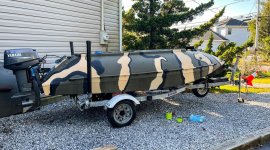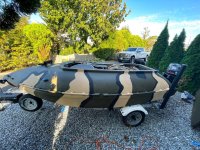Does anyone know if Lock Stock and Barrell is still in business? Or if not, whether there is another source for the FME boat paint Lou Tisch used to sell? I used his paint on my glass over wood sculling boat and it has been incredibly durable, but is in need of touch-up not. I've also just acquired an old Grumman Sport Boat that needs a new coat of paint. I'll stick with what worked before if I can. Checked the website this morning. It is still up, but references a 2017 catalog which makes me wonder. Assuming LSB and FME is not an option, feel free to recommend other paints. The only other boat paint I have used was from Pettit, as bottom paint on an aluminum boat, and I've got not complaints about that, either.
You are using an out of date browser. It may not display this or other websites correctly.
You should upgrade or use an alternative browser.
You should upgrade or use an alternative browser.
Lou Tisch/LSB/FME Paint?
- Thread starter Jeff Reardon
- Start date
Gary Mills
New member
I just bought some from him a month or so ago. Gary
Give him a call? (586) 790-2678.
Found an email address and sent a message. Will try calling if I don't see a response. But Gary's response is encouraging. The FME is great stuff.Give him a call? (586) 790-2678.
roy brewington
Well-known member
If you find he's out of business Kush Paint is brand he sells.
Lou is indeed still in business. Replied to my email last night, still selling his paint, and says he's got someone working to update the website. Question on priming to paint an aluminum boat. This boat has painted before and paint seems to have adhered well but is chalky at the surface and scratched in many places. My plan is to sand down to either well-adhered paint or to clean aluminum. I'll end up with a mix of painted surface and bare aluminum. I assume I can just paint a new layer of FME over all the painted surfaces. What should I do treat the bare metal for good adhesion? Lou's directions suggest two products I can't find, at least at Jamestown or on Amazon. At Jamestown I see etching primers, but I also see some wipe on products. Any suggestions? The number of products at Jamestown was kind of ,mind boggling.
Jeff
I am a firm believer that the primer step cannot be skipped. What I've done in your situation is sand the hull and if you hit aluminum no problem. I don't go down to aluminum everywhere, rather I rough up the existing old painted surface with 80 or 120 grit. I prime with two-part automotive primer and paint with auto paint skipping the clear coat step. Materials are more expensive, but the end result is a very durable surface that won't peel and resists chipping and fading. Plus two-part paints dry much faster speeding the process along. Given the labor involved to flip and strip a boat I take no chances with the new paint failing or not holding up to its environment.
I am a firm believer that the primer step cannot be skipped. What I've done in your situation is sand the hull and if you hit aluminum no problem. I don't go down to aluminum everywhere, rather I rough up the existing old painted surface with 80 or 120 grit. I prime with two-part automotive primer and paint with auto paint skipping the clear coat step. Materials are more expensive, but the end result is a very durable surface that won't peel and resists chipping and fading. Plus two-part paints dry much faster speeding the process along. Given the labor involved to flip and strip a boat I take no chances with the new paint failing or not holding up to its environment.
Are you priming the whole boat, or just the areas where you sanded down to metail?Jeff
I am a firm believer that the primer step cannot be skipped. What I've done in your situation is sand the hull and if you hit aluminum no problem. I don't go down to aluminum everywhere, rather I rough up the existing old painted surface with 80 or 120 grit. I prime with two-part automotive primer and paint with auto paint skipping the clear coat step. Materials are more expensive, but the end result is a very durable surface that won't peel and resists chipping and fading. Plus two-part paints dry much faster speeding the process along. Given the labor involved to flip and strip a boat I take no chances with the new paint failing or not holding up to its environment.
Jeff
The whole boat. I apply by spraying so once the gun is going it takes little time to spray a coat on. When I spray half my time is mixing, gun set-up, and clean-up. The actual spraying time isn't that much so might as well spray all of it.
The whole boat. I apply by spraying so once the gun is going it takes little time to spray a coat on. When I spray half my time is mixing, gun set-up, and clean-up. The actual spraying time isn't that much so might as well spray all of it.
x2 on the paint prep! Lou is awesome, great guy ordered a bunch from him awhile back. Fast delivery. Make sure you prime & prep before any finish coats. I got the original paint scheme codes from TDB and did my 14’ Classic Years Back. This was all hand rolled & brushed.
Attachments
I hear you guys on the paint prep--my questions is what to use for it. This is a 50 year old boat that a friend got when his father in law passed away. It has existing olive paint of unknown age and type, and has been sitting unused long enough to acquired some lichen and moss growth on the side that was in the shade. (This actually makes for an outstanding camo pattern that I almost certainly can't reproduce.) So an extensive sanding job is in my future, and that will almost certainly leave me with some bare metal and some spots I am putting new paint over old. I'll evaluate the need for a complete coat of primer over everything based on how much bare metal vs. sanded paint that's adhering well when I get there. But for the bare metal, it seems to me there are at least three possible approaches. (1) Use some version of an automotive metal primer as Eric suggests. I don't have a paint sprayer--my plan is to roll the finish coat on. There are a bunch of rattle can metal primer paints out there that might be an option. I don't see myself investing in a quality paint gun for this small job. (2) Use a self-etching primer paint. This is what Lou suggests on his instruction page, but he references a couple of products that seem to no longer be available. One similar product--there are many similar--would be this: https://www.nationaltoolwarehouse.c...dwhfBrRGvYoHuHLyLz4Sa61VPhAT7x7hoCy9AQAvD_BwE (3) Use an etching wash on the bare metal, followed by either a standard primer coat or just a first coast of the FME. As I understand it, these are applied to bare metal, allowed to dry, and then must be painted immediately before the aluminum oxidizes again. One product is this: https://www.totalboat.com/products/...FDdA0uCb_s2cLgO_QHdreeFjM--soiWhoCJyIQAvD_BwE
I'm probably overthinking this. For my purposes just sanding and applying over the existing paint would probably be fine, but either self-etching primer or an etching wash would result in something more durable and better looking. But any thoughts on acid etch vs self-etching primer paint would be welcome before I follow Carl's advice and just slap on some fresh paint.
I'm probably overthinking this. For my purposes just sanding and applying over the existing paint would probably be fine, but either self-etching primer or an etching wash would result in something more durable and better looking. But any thoughts on acid etch vs self-etching primer paint would be welcome before I follow Carl's advice and just slap on some fresh paint.
Jeff
The below has been my go-to for decades. Has never failed me. I have also used Parker's grey primer on aluminum. It is cheaper and bonded very well. Either can be rolled.
The below has been my go-to for decades. Has never failed me. I have also used Parker's grey primer on aluminum. It is cheaper and bonded very well. Either can be rolled.
roy brewington
Well-known member
A lot of the old peeling paint as well as everything else can be removed with a pressure washer with narrow stream tip installed. Just got done with a 15' Gruman canoe someone had previously screwed up and old paint job on. All old needed to be removed inside & out. Two days worth of stainless wire brush on 3.5" grinder. After that was done washed it down with strong detergent, rinsed good then applied 50/50 mix of white vinegar & water. This supplies the etching on the newly exposed aluminum. Let that sit wet for about 45 minutes . Rinse off ,dry, wipe down with acetone and spray. Used parkers thinned about 10%. 2 coats. Its been hardening in good sunshine since Saturday morning. I,ll flip this coming weekend and shoot some trk. bedliner on inside floor in hard wear areas. Have done a few boats this way with either Parkers or Kush. Hols up great.I hear you guys on the paint prep--my questions is what to use for it. This is a 50 year old boat that a friend got when his father in law passed away. It has existing olive paint of unknown age and type, and has been sitting unused long enough to acquired some lichen and moss growth on the side that was in the shade. (This actually makes for an outstanding camo pattern that I almost certainly can't reproduce.) So an extensive sanding job is in my future, and that will almost certainly leave me with some bare metal and some spots I am putting new paint over old. I'll evaluate the need for a complete coat of primer over everything based on how much bare metal vs. sanded paint that's adhering well when I get there. But for the bare metal, it seems to me there are at least three possible approaches. (1) Use some version of an automotive metal primer as Eric suggests. I don't have a paint sprayer--my plan is to roll the finish coat on. There are a bunch of rattle can metal primer paints out there that might be an option. I don't see myself investing in a quality paint gun for this small job. (2) Use a self-etching primer paint. This is what Lou suggests on his instruction page, but he references a couple of products that seem to no longer be available. One similar product--there are many similar--would be this: https://www.nationaltoolwarehouse.c...dwhfBrRGvYoHuHLyLz4Sa61VPhAT7x7hoCy9AQAvD_BwE (3) Use an etching wash on the bare metal, followed by either a standard primer coat or just a first coast of the FME. As I understand it, these are applied to bare metal, allowed to dry, and then must be painted immediately before the aluminum oxidizes again. One product is this: https://www.totalboat.com/products/...FDdA0uCb_s2cLgO_QHdreeFjM--soiWhoCJyIQAvD_BwE
I'm probably overthinking this. For my purposes just sanding and applying over the existing paint would probably be fine, but either self-etching primer or an etching wash would result in something more durable and better looking. But any thoughts on acid etch vs self-etching primer paint would be welcome before I follow Carl's advice and just slap on some fresh paint.
Troy Fields
Well-known member
Hi Jeff, When I refinished my red and white Lone Star, I scrubbed it down with just Comet and stainless steel scrubbing pads, like SOS pads. It took off the old paint and lichens, etc. Then I just rinsed and let let dry. I sanded a little bit but the rivet heads were something of a concern. Once it was all cleaned up, I simply used Rustoleum paints and everything held tight for the three years I had it. Best of luckDoes anyone know if Lock Stock and Barrell is still in business? Or if not, whether there is another source for the FME boat paint Lou Tisch used to sell? I used his paint on my glass over wood sculling boat and it has been incredibly durable, but is in need of touch-up not. I've also just acquired an old Grumman Sport Boat that needs a new coat of paint. I'll stick with what worked before if I can. Checked the website this morning. It is still up, but references a 2017 catalog which makes me wonder. Assuming LSB and FME is not an option, feel free to recommend other paints. The only other boat paint I have used was from Pettit, as bottom paint on an aluminum boat, and I've got not complaints about that, either.
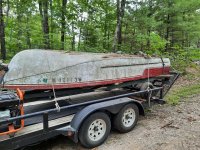
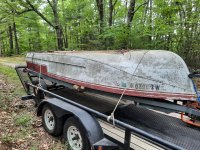

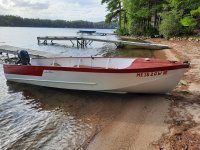
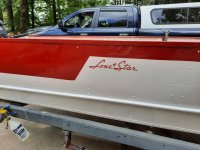
Last edited:


